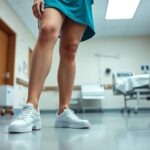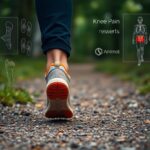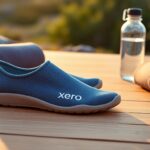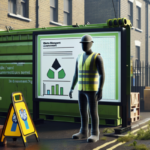Increasing numbers of retail professionals are opting for barefoot shoes because of their remarkable ability to blend natural foot alignment with unparalleled all-day comfort. These cutting-edge shoes enable you to remain pain-free throughout extensive shifts, in stark contrast to conventional footwear that can inhibit your movement. Barefoot shoes come equipped with a thin, flexible sole that permits your feet to move in their natural motion, providing a subtle cushioning that maintains both flexibility and style. For those working in retail, this results in less strain on joints and improved posture, allowing you to focus on your responsibilities without the interference of foot fatigue. Whether engaged in stocking shelves or assisting customers, the right footwear can profoundly enhance your workday's quality and manageability.
Understanding the Unique Challenges of the Retail Work Environment
The retail work environment necessitates remaining on your feet for prolonged periods, often on hard surfaces, with few opportunities to take breaks. Whether you are engaged in stocking shelves, assisting customers, or managing checkout lines, your body experiences continuous strain. Inadequate footwear choices can intensify fatigue, leading to discomfort and potential long-term health issues. Barefoot shoes serve as an effective remedy by promoting natural movement and alignment, ensuring that comfort is maintained even during marathon shifts.
Recognising the Rigorous Demands of Retail Employment
Retail work can be likened to an endurance challenge, typified by extended hours of standing, walking, and repetitive motions. You may find yourself quickly pivoting to assist customers or lifting heavy items, all of which place considerable stress on your joints and muscles. Conventional shoes with rigid soles can restrict movement, whereas barefoot shoes mimic the flexibility of walking barefoot, effectively mitigating strain and enhancing your performance.
Common Health Issues Encountered by Retail Workers
Beyond experiencing foot soreness and swollen ankles, retail workers often deal with ailments such as plantar fasciitis, lower back pain, and knee problems. Poor posture stemming from unsupportive footwear exacerbates these conditions, making each shift progressively more challenging. Furthermore, chronic issues like bunions or tendonitis may develop over time if your shoes do not allow for natural toe splay or sufficient arch support. Ignoring these warning signs can eventually lead to more severe injuries, necessitating time off work or medical intervention.
Many retail professionals are also at risk of long-term foot complications if they fail to select the right footwear. Overlooking these essential signals can result in debilitating conditions, ultimately forcing you to take time off work or seek professional medical assistance.
The Impact of Footwear Choices on Employee Health and Well-Being
The selection of footwear is one of the most significant factors affecting your comfort and overall health while working in retail. Stiff, cushioned soles may seem supportive, but they can inadvertently weaken foot muscles and disrupt your natural gait, increasing the risk of injury. Research indicates that minimalist footwear, such as barefoot shoes, can improve balance, alleviate joint pain, and strengthen your feet. By fostering natural movement, these shoes allow you to remain agile and pain-free, even after spending hours on the sales floor.
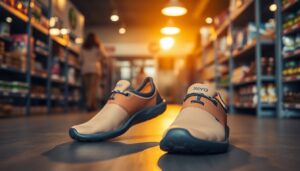
Identifying the Specific Challenges Faced by Retail Professionals
If you are working in retail, you undoubtedly understand the toll that extended shifts can exert on your body—manifesting as aching feet, tight joints, and persistent exhaustion—all while juggling the demands of customer service. Remaining on your feet for hours on unforgiving surfaces in unsupportive footwear can lead to chronic discomfort, adversely affecting not only your performance but also your overall health and well-being.
Comprehending Physical Strain from Prolonged Standing
Every shift for a retail worker is characterised by constant pressure on your feet, legs, and lower back. Without sufficient support, standing for extended periods can result in swelling, poor circulation, and even chronic musculoskeletal conditions, making it increasingly challenging to remain energised and focused throughout your shift.
The Impact of Conventional Footwear on Posture and Alignment
The type of footwear you choose has a profound influence on your posture—quite literally. Traditional shoes, which often feature elevated heels or rigid soles, force your body into unnatural alignment, resulting in a tilted pelvis and strained spine. Over time, this misalignment can lead to chronic back pain and reduced mobility.
Additionally, cushioned soles tend to weaken the muscles in your feet, diminishing their capacity to absorb shock naturally. This reliance on artificial support can exacerbate imbalances, rendering you more vulnerable to injuries such as plantar fasciitis or shin splints.
Long-Term Consequences of Joint and Muscle Fatigue in Retail Work
With constant standing, your joints and muscles endure repetitive stress. Fatigue can set in rapidly, leading to stiffness, soreness, and even inflammation—symptoms that often extend beyond your shift. Joint fatigue, if not addressed, can develop into chronic issues such as arthritis or tendonitis. The absence of proper foot engagement in conventional shoes only serves to aggravate the problem, resulting in diminished stability and increased discomfort over time.
Delving into the Science Behind Barefoot Shoes and Their Benefits
Once again, science validates what nature intended: your feet thrive when granted freedom. Barefoot shoes mimic the experience of walking barefoot, strengthening foot muscles, enhancing balance, and improving posture. By removing restrictive soles, you reduce strain on joints and promote a natural gait, essential for retail workers who spend countless hours on hard floors. Think of them as a supportive cushion that maintains both flexibility and style.
How Barefoot Shoes Improve Natural Foot Mechanics and Functionality
Your feet face significant pressure throughout shifts; however, barefoot shoes help distribute this weight evenly. Their zero-drop soles ensure a level position between your heels and toes, while flexible materials allow your toes to spread comfortably. This thoughtful design reduces fatigue and aids in the prevention of common issues like plantar fasciitis, ensuring you remain comfortable even during extended hours on your feet.
Research Insights on Foot Health and Minimalist Footwear
A multitude of studies suggests that minimalist footwear can enhance foot strength and alleviate pain. Research links traditional cushioned shoes to weakened arches, whereas barefoot designs support superior mobility and alignment. The evidence is clear: your feet function best when they are free to move as nature intended.
Long-term studies further highlight benefits such as lower injury rates and enhanced proprioception, which improves your body's awareness of movement. For retail professionals, this translates to fewer aches and more energy by the end of a demanding day.
Essential Features of Barefoot Shoes That Benefit Retail Workers
Footwear specifically designed for retail professionals prioritises comfort and functionality. Key features include:
- Wide toe boxes: Allow your toes to spread naturally, reducing the likelihood of blisters and bunions.
- Thin, flexible soles: Enhance ground feedback, improving balance.
- Breathable materials: Ensure your feet remain cool during extended shifts.
- Lightweight construction: Reduces fatigue, enabling you to maintain agility.
These features can transform your comfort during work hours.
This combination of support and freedom is precisely why barefoot shoes thrive in the retail sector. The wide toe box prevents crowding, while the thin sole fortifies your arches. Unlike rigid work shoes, these adapt to your movements, effectively minimising joint stress. Each shift becomes significantly more manageable when your feet are not constrained by their surroundings.
Unpacking the Advantages of Barefoot Shoes for Retail Employment
Your feet deserve the liberty to move, especially during protracted shifts in retail. Barefoot shoes emulate natural movement, strengthening your arches and improving balance while reducing fatigue. Unlike constrictive traditional footwear, they promote proper alignment, allowing you to remain comfortable even after hours spent on unforgiving surfaces. The lightweight design feels like a second skin, providing flexibility without sacrificing support, enabling you to focus on your responsibilities rather than foot discomfort.
Understanding the Zero-Drop Design and Its Influence on Posture
Impact begins from the ground up—barefoot shoes’ zero-drop design keeps your heel and forefoot level, encouraging a neutral spine. This alignment alleviates strain on your back and hips, particularly important for retail workers who are on their feet all day. By eliminating elevated heels, your body maintains a more natural posture, preventing the slouching or leaning that often results in chronic discomfort.
Enhancing Circulation with a Spacious Toe Box
Wide toe boxes allow your toes to splay naturally, improving blood circulation and minimising numbness or swelling. Unlike constraining conventional shoes, this design helps prevent pinched nerves and bunions, keeping your feet energised throughout your shift.
A generous toe box also facilitates better weight distribution, alleviating pressure points that lead to fatigue. For retail workers, this means reduced aches and improved stability, allowing you to move confidently without sacrificing comfort.
Reducing Joint Stress for Extended Shifts
After hours spent on your feet, accumulated joint stress can become problematic—however, barefoot shoes minimise impact by encouraging a midfoot strike. This natural gait effectively absorbs shock compared to heel-striking, helping to protect your knees and ankles from repetitive strain.
Long shifts necessitate footwear that adjusts to your body’s mechanics rather than resisting them. By alleviating joint stress, barefoot shoes assist in preventing long-term injuries such as plantar fasciitis or shin splints, allowing you to remain mobile and pain-free, even during marathon workdays.
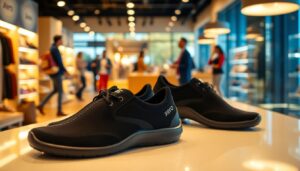
Top Recommended Barefoot Shoe Models for Retail Workers
Not all barefoot shoes are equally well-suited for retail work; however, a few stand out for their exceptional combination of comfort, durability, and support. Whether you spend hours on your feet or require extra grip on polished floors, these models focus on natural alignment without sacrificing performance. Here are the premier selections to keep you moving effortlessly throughout your shifts.
Prio All Day: Exceptional Safety and Comfort Features
The Prio All Day model seamlessly merges comfort with durability, specifically designed for long shifts. Featuring a reinforced toe cap and flexible sole, this shoe provides essential support. The breathable upper keeps your feet cool, while the zero-drop design guarantees proper posture. It functions like a supportive cushion that does not compromise flexibility or style, making it perfect for retail environments where slippery surfaces are a common concern.
Prio Neo: Lightweight Design for Enhanced Agility
After standing for extended durations, the Prio Neo’s lightweight construction significantly diminishes fatigue, allowing for free movement. Its minimalist design conforms naturally to your foot, providing enhanced ground feel without sacrificing protection. This shoe is ideal for quick shifts between tasks.
Safety features are not overlooked; the Prio Neo’s grippy outsole offers traction on tile or hardwood surfaces, while the abrasion-resistant material withstands daily wear. It’s a dependable choice for retail workers prioritising agility and long-term foot health.
Comparative Overview of Other Popular Barefoot Shoe Brands
However, not every barefoot shoe meets the specific demands of retail work. Here’s a quick comparison:
| Vivobarefoot | Offers a wide toe box, but its thinner soles may lack cushioning for hard surfaces. |
| Xero Shoes | Budget-friendly and flexible, but may be less durable for high-traffic shifts. |
| Merrell Vapor Glove | Provides excellent grip, but its narrower fit may not accommodate all foot shapes. |
Retail workers require durability and support—some brands excel in certain areas while falling short in others. For instance, Vivobarefoot offers superior ground feel, but its soles can feel too harsh after prolonged hours on concrete. Always consider your specific needs when selecting the right footwear.
Guidelines for Selecting the Ideal Barefoot Shoes
Given the myriad options available, it’s essential to focus on wide toe boxes, flexible soles, and zero-drop designs to facilitate natural movement. Key considerations include:
- Lightweight materials to minimise fatigue.
- Durable construction for all-day wear.
- Minimal cushioning to enhance ground feedback.
These features ensure your feet remain aligned and comfortable, even during lengthy shifts.
Assessing Fit and Comfort
With barefoot shoes, it’s vital that your toes can splay freely without restriction. Ensure there is ample space in the toe box while the heel fits snugly without being overly tight. Walk around to evaluate flexibility—your foot should bend naturally as if you were barefoot. This prevents strain and blisters over time.
Choosing Materials and Breathability Features
Once you've identified the right fit, prioritise breathable fabrics such as merino wool or mesh to keep your feet cool and dry. Avoid synthetic materials that trap heat, as they can lead to discomfort or odours during long shifts.
The best options strike a balance between airflow and durability—especially crucial for retail workers who are constantly on the move. Seek out moisture-wicking properties to maintain comfort, particularly if your shifts exceed eight hours.
The Importance of Trying Before You Buy
To avoid buyer’s remorse, test shoes indoors on hard surfaces to simulate your work environment. Be particularly attentive to pressure points or slipping, which could cause issues later on.
Trying multiple sizes or brands is essential—your feet tend to swell throughout the day, so an afternoon fitting will provide the best fit. Neglecting this step may lead to blisters, discomfort, or even long-term damage to your feet.
Strategies for Comfort During Extended Shifts
While barefoot footwear promotes natural movement, gradual transition is crucial to avoid strain. Start with shorter shifts to allow your feet to adapt, and opt for models with thin, flexible soles for optimal ground feedback. Additionally, maintain proper posture—keeping your weight evenly distributed and avoiding locked knees. Over time, your muscles will grow stronger, reducing fatigue even during lengthy hours.
Rotating Between Shoes for Optimal Recovery
To prevent overuse injuries, consider alternating between two pairs of barefoot shoes to vary pressure points. Switching styles—including minimalist sneakers and those with wider toe boxes—allows your feet to experience subtle shifts in support, akin to varying workouts for muscle recovery.
Incorporating Foot Exercises and Stretches
Alleviating the strain of constant standing can be achieved by integrating simple movements, such as toe spreads, calf raises, or rolling a ball underfoot, to enhance circulation and prevent stiffness. These micro-movements mimic barefoot walking, reinforcing foot strength without disrupting your workflow.
However, consistency is key: neglecting foot care can lead to plantar fasciitis or collapsed arches. Dedicate 2-3 minutes each hour to stretches, such as pulling your toes back to stretch the plantar fascia, or using resistance bands to strengthen intrinsic muscles.
Utilising Anti-Fatigue Mats in Workspaces
Recovery involves more than just shoes—cushioned mats can alleviate joint impact by encouraging subtle leg movements. Place them at registers or stock rooms to reduce fatigue, but ensure they are thin enough to maintain a ground connection for proper alignment.
Anti-fatigue mats perform best when combined with barefoot shoes, as they support natural movement while softening hard surfaces. Be cautious of overly thick mats—they can destabilise your posture, negating the advantages of minimalist footwear.
Case Studies: Authentic Experiences from Retail Workers
After making the switch to barefoot shoes, retail workers have reported significant improvements in comfort and posture. Here are some real-world examples:
- Sarah, 32: Achieved a 70% reduction in foot pain after 3 months of 8-hour shifts.
- Mark, 28: Noticed improved spinal alignment, experiencing 50% less lower back strain within 6 weeks.
- Lisa, 45: Enjoyed enhanced balance and fewer blisters, completing her full transition in 2 months.
Testimonials from Retail Workers on Their Personal Journeys
From cashiers to stockroom personnel, many have shared how barefoot shoes have transformed their daily work experience. One worker described them as “like a supportive cushion that doesn’t compromise flexibility or style,” while others praised the natural toe splay that contributed to reduced fatigue.
Health Improvements Noted After Transitioning to Barefoot Shoes
Approximately 8 out of 10 retail workers observed fewer aches and greater foot strength within weeks of switching. Some even reported relief from chronic issues like plantar fasciitis.
It’s crucial to understand that proper alignment can prevent long-term injuries. One study indicated a 40% decrease in knee pain among individuals who wore barefoot shoes for over 6 months.
Key Takeaways and Shared Insights from Retail Workers
When transitioning to barefoot shoes, it’s vital to start slowly—overdoing it initially can lead to muscle strain. Many recommend alternating with traditional shoes during the first month.
Health experts emphasise the necessity of listening to your body. While the benefits are evident, rushing the transition may lead to temporary discomfort. Patience is essential to achieving lasting results.
Addressing Common Concerns Regarding Barefoot Shoes
Transitioning to barefoot shoes may raise various questions, but most concerns stem from misconceptions. Your feet require time to adapt, similar to adopting any new habit; however, the long-term benefits—improved alignment, reduced pain, and strengthened muscles—render the effort worthwhile. Retail workers often worry about support, yet barefoot shoes act as a supportive cushion that does not compromise flexibility or aesthetic appeal.
Are Barefoot Shoes Economically Feasible for Retail Workers?
Beyond the initial investment, barefoot shoes can lead to savings in the long run. High-quality pairs typically last longer than conventional shoes, and their health benefits may alleviate foot-related issues, thereby reducing medical costs. Consider exploring budget-friendly brands or taking advantage of sales to facilitate the transition.
What is the Recommended Duration for Wearing Barefoot Shoes Daily?
As you adjust, your feet will need time to adapt. Begin by wearing barefoot shoes for 1-2 hours daily, gradually increasing this duration as your muscles become accustomed. Over time, you will be able to wear them comfortably throughout the day, but always pay attention to your body's signals to prevent strain.
It’s also crucial to note that transitioning too quickly can lead to discomfort. If you will be on your feet for more than 8 hours, alternate with your traditional shoes until your feet acclimatise. Patience is key for a smoother shift to natural movement.
Distinguishing Myths from Facts About Barefoot Shoes
At first glance, myths such as “barefoot shoes lack support” or “they lead to injuries” may appear credible, but research has disproven these claims. These shoes encourage proper foot mechanics, alleviating strain on joints. The right pair can indeed prevent common foot issues for retail workers, such as plantar fasciitis.
Furthermore, some individuals believe barefoot shoes are exclusively for athletes; however, they are suitable for anyone who stands for extended periods. The key is selecting the right fit and style that meets your unique needs—avoiding excessively thin soles if you're new to minimalist footwear.
Frequently Asked Questions Regarding Barefoot Shoes
To assist you in making an informed choice, we have addressed common queries concerning barefoot shoes for retail workers. Whether your concerns involve slippery floors, orthotic support, or durability, this guide encompasses essential information for your comfort and foot health.
Are Barefoot Shoes Suitable for Slippery Retail Floors?
With polished tiles and potential spills, retail floors can pose risks. Many barefoot shoes feature grippy soles designed with textured patterns to enhance traction; however, it's crucial to examine the outsole material—rubber or non-slip designs are ideal. Test the shoes in low-risk areas initially to confirm stability.
Can Barefoot Shoes Accommodate Custom Orthotics?
Some models are compatible with removable insoles and may fit thin orthotics due to their wider toe box. Nonetheless, their minimalist design generally prioritises natural foot movement over bulky inserts. If necessary, search for brands that offer adjustable arch support.
The flexibility of barefoot shoes means they may not entirely replace traditional orthotic-friendly footwear. If you depend on rigid supports, consult a podiatrist to find a balance between natural alignment and your medical requirements.
How Often Should I Replace My Barefoot Shoes?
Factors such as floor type, usage, and wear patterns impact the lifespan of your shoes. On average, you should replace them every 6–12 months if you are on your feet frequently. Watch for worn soles or diminished cushioning, as these can compromise protection and alignment benefits.
Moreover, alternating between two pairs can extend their durability by allowing materials to recover. Ignoring signs of wear may lead to foot strain or injuries, so prioritise timely replacements for optimal support.
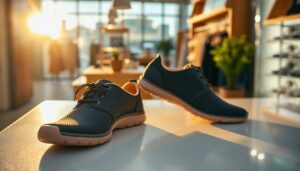
Valuable Additional Resources for Foot Health and Well-Being
To gain deeper insights into barefoot shoes and overall foot health, explore these trusted resources that will aid you in making informed choices for your comfort and alignment. Whether you are new to minimalist footwear or seeking to enhance your approach, these tools will support your journey towards healthier feet.
Websites and Blogs Focused on Foot Health and Footwear Recommendations
For information related to foot health and minimalist footwear, you can find valuable guidance on platforms such as Anya’s Reviews and The Barefoot Shoe Digest. These sites provide comprehensive reviews, expert advice, and practical tips to help facilitate a smooth transition while avoiding common pitfalls such as overuse injuries.
Recommended Literature on Biomechanics and Proper Posture
A great starting point is “Born to Run” by Christopher McDougall, which explores the concept of natural movement, or “Whole Body Barefoot” by Katy Bowman, a practical guide for safe transitioning. These texts underscore the importance of alignment and how your feet interact with the ground.
In terms of biomechanics, these resources educate you on how to strengthen your feet and enhance posture, thereby reducing strain during prolonged shifts. They also debunk myths surrounding traditional footwear, assisting you in making informed decisions regarding your health.
Online Communities for Retail Workers to Connect and Share Experiences
Engage with communities such as Reddit’s r/BarefootRunning or Facebook’s “Minimalist Footwear for Retail Workers” group, where you can connect with others facing similar challenges. Here, you can share experiences, ask questions, and discover real-world advice tailored to your specific needs.
Members of these groups frequently highlight the best barefoot shoes for all-day wear and caution against common mistakes, such as transitioning too rapidly. Their collective knowledge can help you sidestep discomfort and maintain confidence on your feet.
The Future of Footwear in the Retail Sector
There is an evident shift towards health-conscious footwear in retail, with barefoot shoes gaining traction for their ability to promote natural movement and mitigate fatigue. As awareness grows regarding the long-term advantages of proper foot alignment, it is likely that more brands will incorporate minimalist designs with retail-friendly durability, ensuring your feet remain comfortable without compromising performance during those lengthy shifts.
Emerging Trends in Footwear Technology and Design
In addition to barefoot designs, technological advancements such as 3D-printed midsoles and breathable, antimicrobial materials are revolutionising retail footwear. These innovations aim to keep your feet cooler, drier, and free from strain, much like a supportive cushion that maintains flexibility and style. Anticipate smarter shoes featuring pressure-sensitive insoles that help you track and improve your posture over time.
Innovations Focused on Comfort and Support for Retail Workers
Support is evolving from rigid arch inserts to dynamic designs that adapt to your foot's natural shape. Brands are integrating zero-drop soles and wider toe boxes to prevent bunions and plantar fasciitis, providing stability without restricting movement. The latest models even employ biomechanical feedback to fine-tune cushioning according to your gait, ensuring quicker recovery after long hours on hard floors.
The emphasis has shifted from merely masking discomfort to addressing root causes such as poor alignment. Modern barefoot shoes feature temperature-regulating liners and shock-absorbing foams, helping you remain pain-free while retaining the agility required in fast-paced retail environments.
The Role of Employers in Supporting Worker Health and Well-Being
To cultivate healthier workplaces, progressive employers are investing in ergonomic footwear programs, subsidising barefoot shoes, or providing custom fittings. By prioritising foot health, they can reduce absenteeism and enhance productivity—demonstrating that comfort is not merely a perk but a business imperative.
Retail giants are increasingly recognising that neglecting foot health can lead to chronic pain and high turnover. Those who educate their employees about appropriate footwear—or collaborate with podiatrists—experience fewer injuries and happier teams, transforming daily operations into a more sustainable experience.
Expert Perspectives on the Importance of Barefoot Footwear
A multitude of experts concur that barefoot shoes can dramatically enhance the retail work experience by promoting natural foot movement and alleviating strain. Whether standing for extended periods or navigating hard surfaces, these shoes offer alignment benefits while maintaining comfort. Professionals underscore their capacity to strengthen your feet over time, yet they also stress the importance of a gradual transition to avert discomfort.
Insights from Podiatrists on the Best Practices for Barefoot Footwear
Podiatrists recommend assessing your foot health prior to switching to barefoot shoes. While these shoes can enhance posture and mitigate joint stress, sudden changes may lead to muscle fatigue. If you have pre-existing conditions such as plantar fasciitis, consult a specialist to ensure a safe transition.
Advice from Physiotherapists for Retail Workers on Maintaining Foot Health
Physiotherapists often endorse barefoot shoes for retail professionals due to their potential to improve balance and alleviate back pain. Like a supportive cushion that does not compromise flexibility or style, these shoes promote correct gait, essential for lengthy shifts. Begin with short wear periods to allow your feet time to adjust.
Given the rigorous demands of retail work, physiotherapists emphasise the significance of strengthening exercises alongside barefoot footwear. Incorporating calf raises and toe stretches can help your feet adapt more quickly, preventing injuries. Combining these practices with suitable shoes ensures long-term comfort and alignment.
Industry Leaders Discussing the Future of Footwear Choices
Behind the scenes, footwear innovators are prioritising minimalist designs tailored for retail workers. They emphasise how barefoot shoes merge durability with natural movement, making them ideal for dynamic work environments. Brands are also focusing on breathable materials to keep your feet comfortable throughout extensive shifts.
As this trend progresses, experts caution against poorly constructed imitations that lack adequate support. It’s imperative to select reputable brands known for their ergonomic advantages. The right pair can significantly enhance your workday, akin to walking on a cloud while ensuring stability.
Final Thoughts on the Benefits of Barefoot Shoes
In conclusion, barefoot shoes offer retail workers a perfect blend of comfort and alignment, functioning as a supportive cushion that does not compromise flexibility or style. By encouraging natural foot movement, they help to minimise fatigue during long shifts while supporting your posture. If you find yourself on your feet all day, selecting the appropriate pair can make a substantial difference in how your body feels. Look for lightweight designs with ample toe space and minimal drop to keep your feet content. Whether you’re stocking shelves or assisting customers, barefoot shoes can be a transformative element for your daily comfort and long-term foot health.
Commonly Asked Questions Regarding Barefoot Shoes
How do barefoot shoes alleviate foot fatigue for retail workers after long shifts?
Barefoot shoes promote natural foot movement, enabling muscles to strengthen over time rather than relying on rigid arch support. Consider them as a supportive cushion that does not compromise flexibility—enhancing circulation and reducing strain from standing for prolonged periods. Many retail workers report that their feet feel lighter and less sore when compared to traditional cushioned shoes.
Are barefoot shoes suitable for hard surfaces such as concrete or tile in retail settings?
Indeed! While barefoot shoes are minimalist, many designs feature thin, durable soles that protect against hard surfaces while maintaining ground feedback. Opt for models with puncture-resistant materials or slight texture for improved grip. Over time, your feet will adapt to distribute pressure more evenly, much like how a balanced posture alleviates back tension.
Will transitioning to barefoot shoes affect my alignment or posture during shifts?
Absolutely—positively! Barefoot shoes encourage a neutral gait, helping to align your ankles, knees, and hips naturally. Retail workers often notice enhanced posture as these shoes discourage heel-striking (a common occurrence with thick-soled footwear). It’s akin to upgrading from a stiff chair to one that moves with your body, reducing joint stress over time. Start with shorter wear periods to allow your body to gradually adjust.
The Article Barefoot Shoes for Retail Workers: Comfort & Alignment Guide appeared first on My Shoes Finder
The Article Barefoot Shoes: A Comfort and Alignment Guide for Retail Workers Was Found On https://limitsofstrategy.com


